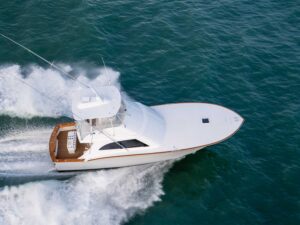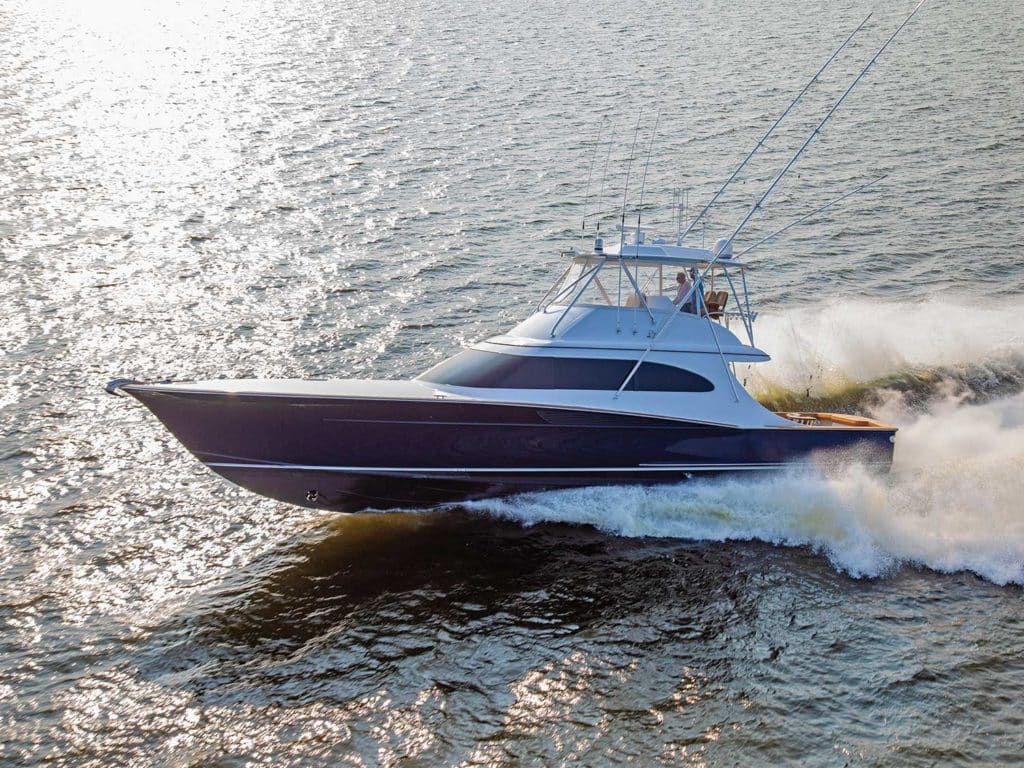
When Spencer Yachts launched its first water-jet-powered sport-fisher, Jet Stream, a few years ago, the build raised quite a few eyebrows: A 50-foot Carolina-built beauty capable of 50-knot speeds, ultra-shallow draft, and incredible maneuverability offered by the Marine Jet Power propulsion system generated substantial dockside chatter. Unfortunately for us at Marlin, the boat was bound for a freshwater existence on Lake St. Clair outside Detroit, Michigan. The good news: Spencer’s next jet boat, the 63-foot Wall Hanger, was well worth the wait.
After an invitation from Paul Spencer, we set a date to fish the boat in early September. And then, in typical fall Oregon Inlet fashion, a stiff wind blew out of the northeast on the only day we had open, so our trip offshore morphed into an extended sea trial on Croatan Sound, giving us the opportunity to really put Wall Hanger through her paces with Spencer himself at the wheel.
My first question for unique builds like this is always, “What was this boat designed to do?” Wall Hanger’s owner—a passionate, hands-on boater and fisherman with plenty of experience in fast center-consoles—needed his dream vessel to have a draft of less than 4 feet in order to access his waterfront property in Morehead City, North Carolina. He had ridden on Jet Stream during the initial sea trials and wanted to build a 63-footer with the same propulsion system. He wanted a good-looking dayboat that would be just as comfortable trolling the 100-fathom curve with his family as it would be cruising the shallows of the Intracoastal Waterway heading to a Sunday afternoon sandbar party—and he got it.
Cockpit
After a brief meeting with Paul Spencer, his son, Daniel, Wall Hanger’s Capt. Jonathan Oglesby and Spencer Yachts’ manager of new projects and all-around fountain of engineering knowledge, Chris Blanchard, we stepped aboard. The first thing I noticed was the Flexiteek synthetic teak decking rather than the usual natural raw teak we’re used to seeing on the cockpit sole. With durability and low maintenance as priorities on this build, it’s a smart choice because this product is virtually impervious to oil, sunscreen, damage from pets, and pretty much anything else. Other than that, the layout was all Spencer: transom fish box, Release Marine Trillion Series fighting chair, teak covering boards and a well-laid-out, air-conditioned mezzanine. The ice dump is to port, with a drink box aft of the salon door, and plenty of stainless-steel-lined, refrigerated bait storage within easy reach; beneath the mezzanine seating was a cavernous amount of dry storage. Also notable was the lack of in-deck boxes—Spencer prefers to keep the deck in one piece to prevent the possibility of saltwater intrusion in the lazarette.
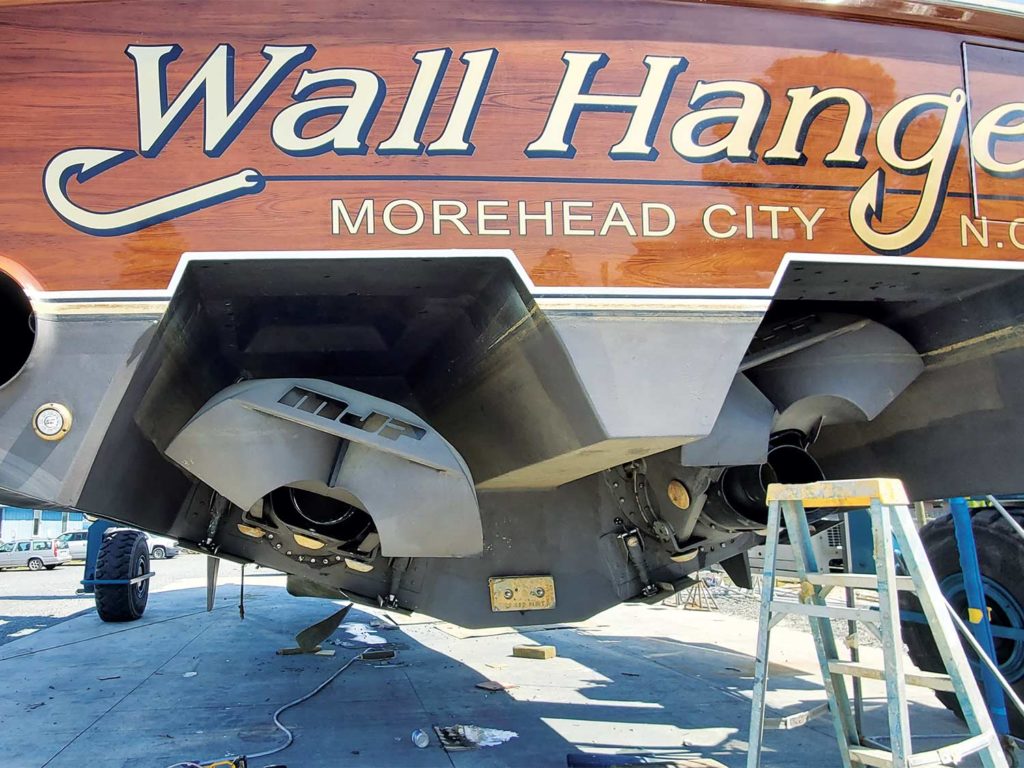
Engine Room
Heading below to the engine room, it’s fairly straightforward at first: a pair of Caterpillar C32 ACERTs rated at 1,700 hp each, as well as a 29 kW Cat genset all the way forward to port, and a Dometic SeaXChange-Spot Zero system on the starboard side. Moving aft, however, is where the boat gets interesting. The engines are connected by drive shafts to the Marine Jet Power 400 water-jet-propulsion drives, with intakes in the bottom below the drive shafts and the exhausts aft, through the transom below the waterline. According to Blanchard, it’s a mixed-flow jet system similar to those used on commercial fast ferries, military craft and other high-speed commercial operations around the world, and it’s nearly bulletproof. The key to the system is the double-reversing bucket at each nozzle that directs the water jet’s exhaust stream up and down with steering and throttle input from the helm; the jet nozzles move from side to side. The hydraulics are inside the hull, and a Seakeeper 18 resides between the two drives.
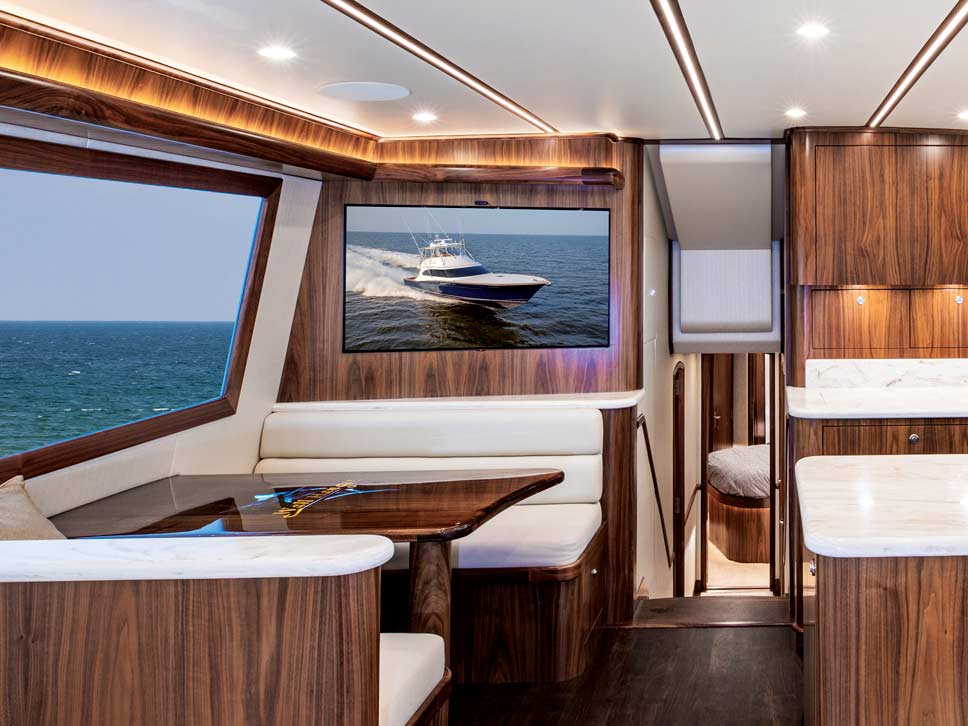
Interior and Helm
Moving into the salon, the layout is both conventional and comfortable, with a large sofa to port and an L-shaped lounge on the starboard side. A triangular padded ottoman slides neatly into the L to fill out the space for family napping, while the sofa contains the majority of the boat’s tackle storage beneath it so guests aren’t disturbed when you need to grab a spare dredge weight. Moving forward, the dinette sits to port with the galley starboard, complete with Sub-Zero refrigerator and freezer drawers below the beautiful beige-and-cream-colored Corian Dune Prima countertops. The satin teak woodwork with crown molding highlights the understated classiness of the look, which is further streamlined by the use of Smart Tint privacy windows that go dark with the touch of a button, eliminating the need for conventional blinds.
Heading below, there is a double-bunk stateroom to port and over-and-under bunks in the starboard stateroom, with loads of rod storage beneath each upper bunk; the guest head is to starboard. The master stateroom is all the way forward, with an en suite head in the forepeak.
Ascending to the bridge, the peninsula-style helm has plenty of room for a trio of Garmin multifunctional displays—one 12-inch unit dedicated to camera feeds from the engine room, plus a pair of 18-inch units—as well as a Simrad autopilot, Furuno radar and Omni sonar. The departure from a conventional sport-fish continues here with the electronic MJP display, which shows the location of the buckets, plus a push-button control panel and joystick.
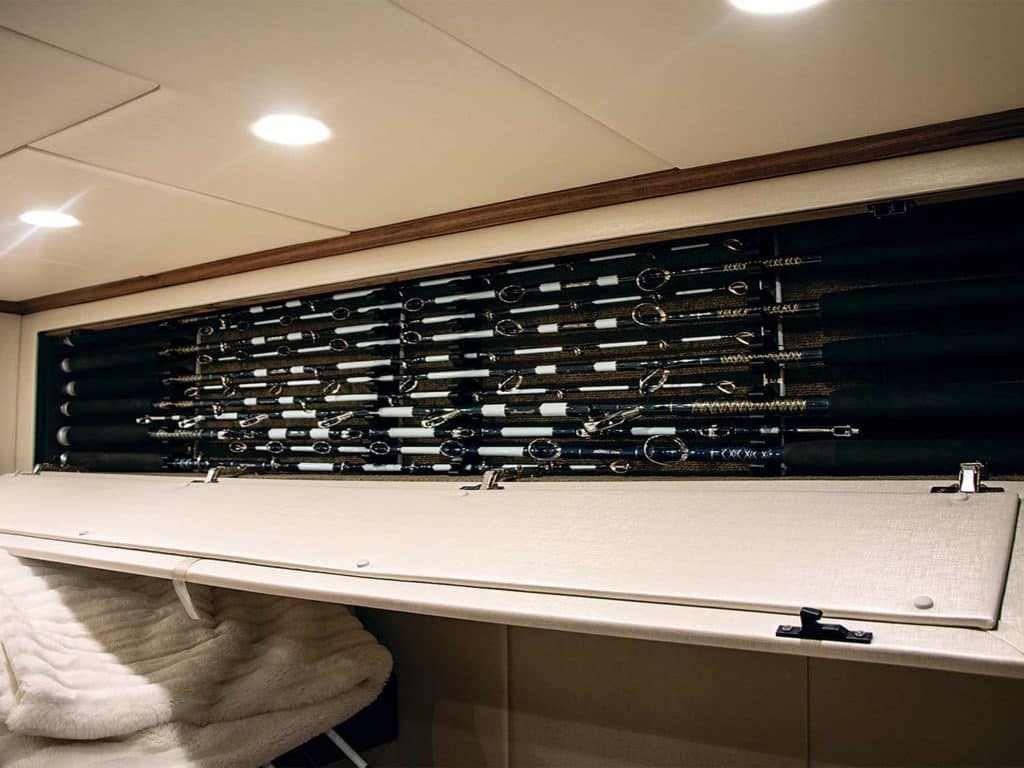
Performance
The Spencer team designed the hull with 19 degrees of deadrise at the transom, and it’s carried farther aft than usual to give Wall Hanger excellent rough-water performance; it drafts 38 inches at rest, but there are no protrusions below the hull. This is a boat you could beach on the sandbar for lunch, and back it off just as easily without damaging a thing.
What about sucking up debris? The beefy water intakes are not screened: Weeds and other debris are sucked up and churned out through the large stainless-steel impellers in each drive without hesitation, and the system can be reversed with the push of a button to flush out debris as well (a screen would prevent a good back-flushing).
And let’s just say the performance is pretty incredible. At a 75 percent load, we were cruising at 40 knots and burning 140 gallons per hour. At 80 percent, the speed increased to 45 knots, and wide-open throttle saw an eye-watering 51 knots. Keep in mind this performance is in a ready-to-fish condition. Maneuverability was equally impressive, with Spencer easily spinning the boat within her own length, thanks to the vectored thrust from the jet-drive buckets. Wall Hanger tracked arrow-straight while backing down, hitting 7.5 knots in reverse without flooding the cockpit or taking water over the transom, and she had plenty left to go. Using the joystick, Spencer jogged the boat perfectly sideways into a 15-knot northeast breeze.
While water-jet drives may be new in the sport-fishing market, they’ve been around for a long time in high-speed commercial applications. Jets are not intended to replace conventional prop-and-shaft propulsion, but for specialized applications like ultra-shallow draft and high cruising speeds, they are a viable option that is worthy of consideration.
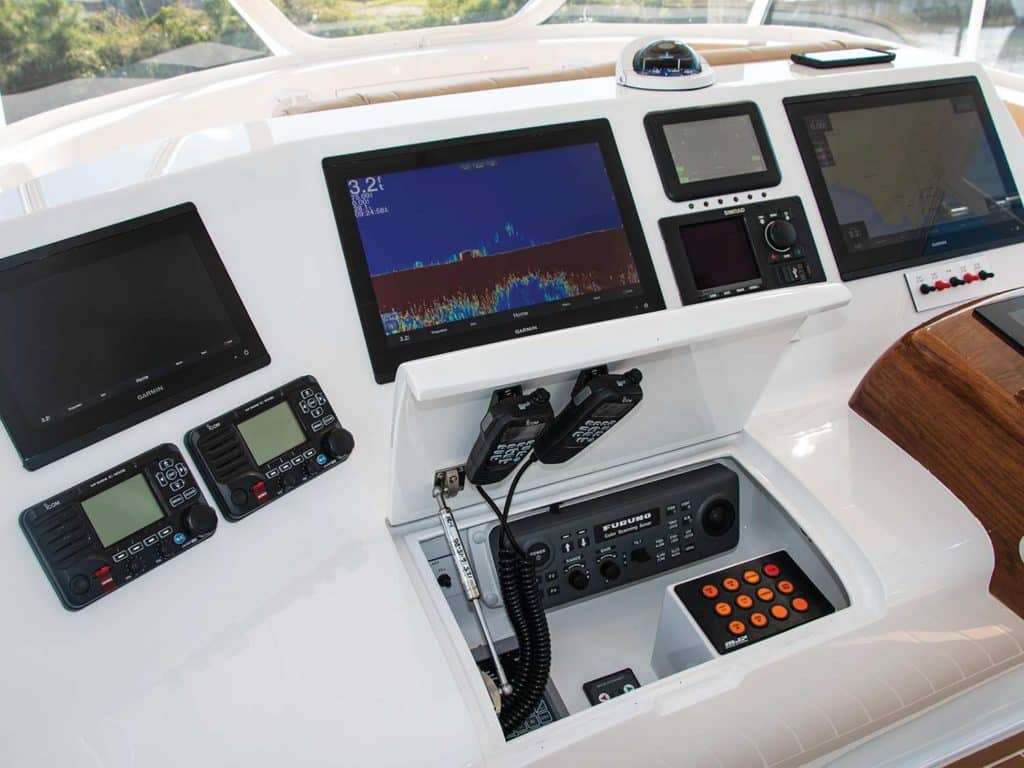
Spencer 63 Specs
- LOA: 63′
- BEAM: 17′6″
- DRAFT: 38″
- DISPL: 60,000 lb.
- FUEL: 1,700 gal.
- WATER: 300 gal.
- POWER: Twin 1,700 hp Cat C32A
- GEAR/RATIO: N/A
- DRIVES: MJP 400
- PAINT: Awlgrip, Flag Blue
- CLIMATE CONTROL: Dometic
This article originally appeared in the December 2021 print issue of Marlin.
